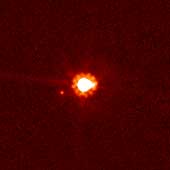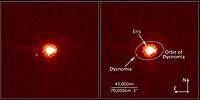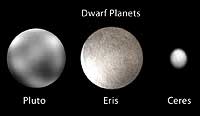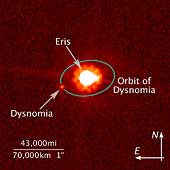
Eris (UB313) was named after the Greek goddess of discord and strife. She stirs up jealousy and envy to cause fighting and anger among men. At the wedding of Peleus and Thetis all the gods were invited with the exception of Eris, and, enraged at her exclusion, she spitefully caused a quarrel among the goddesses that led to the Trojan war.
Aptly named, the icy dwarf planet, Eris, has rattled the general model of our solar system. The object was discovered on January 5, 2005 by Mike Brown, Chad Trujillo and David Rabinowitz at Palomar observatory in the out reaches of the Kuiper belt. The discovery came from images taken on October 21, 2003. It was announced on July 29, 2005.
Its detection provoked debate about Pluto's classification as a planet. Eris is slightly larger than Pluto.
So if Pluto qualified as a full-fledged planet, then Eris certainly should too. Astronomers attending the International Astronomical Union meeting in 2006 worked to settle this dilemma. In the end, we lost a planet rather than gaining one. Pluto was reclassified as a dwarf planet along with Eris and the asteroid Ceres, the most massive member of the asteroid belt.
Eris is the largest dwarf planet in the solar system and is the largest object found in orbit around the Sun since the discovery of Neptune and its moon Triton in 1846. It has a diameter between 2,400 and 3,000 kilometres (1,490 to 1,860 miles) and is 27% more massive than Pluto.
Eris is the most distant object ever seen in orbit around the Sun, even more distant than Sedna, the Kuiper Belt object discovered in 2003. It is almost 10 billion miles from the Sun and more than 3 times more distant than Pluto and takes more than twice as long to orbit the Sun as Pluto. It has an orbital period of 556.7 years.
 Hubble View of Eris and Dysnomia
Hubble View of Eris and Dysnomia
[Left] - This is an image of the dwarf planet Eris (center) and its satellite
Dysnomia (at 9 o'clock position) taken with NASA's Hubble Space Telescope on
Aug. 30, 2006. Hubble observations were obtained on Dec. 3, 2005 and Aug. 30,
2006 using the Advanced Camera for Surveys. The Hubble images were combined with
images from the Keck telescopes taken on Aug. 20, 21, 30, and 31 to measure the
satellite's orbit and calculate a mass for Eris, which is the largest dwarf
planet in the solar system.
[Right] - Labeled version of the above mentioned image of dwarf planet Eris and its satellite Dysnomia taken with NASA's Hubble Space Telescope on Aug. 30, 2006. Dysnomia's projected orbit around Eris is superimposed on the image.
(Credit: NASA, ESA, and M. Brown)
 Dwarf Planets
Dwarf Planets
The following images represent the three newly designated dwarf planets. The
image of Pluto was rendered from a map created from a servies of Hubble images.
Eris is an artistic image, and Ceres is a Hubble telescope image.
(Copyright Calvin J. Hamilton)
 Hubble View of Eris and Dysnomia
Hubble View of Eris and Dysnomia
This is an image of the dwarf planet Eris (center) and its satellite Dysnomia
(at 9 o'clock position) taken with NASA's Hubble Space Telescope on Aug. 30,
2006. Hubble observations were obtained on Dec. 3, 2005 and Aug. 30, 2006
using the Advanced Camera for Surveys. The Hubble images were combined with
images from the Keck telescopes taken on Aug. 20, 21, 30, and 31 to measure
the satellite's orbit and calculate a mass for Eris, which is the largest
dwarf planet in the solar system.
(Credit: NASA, ESA, and M. Brown)